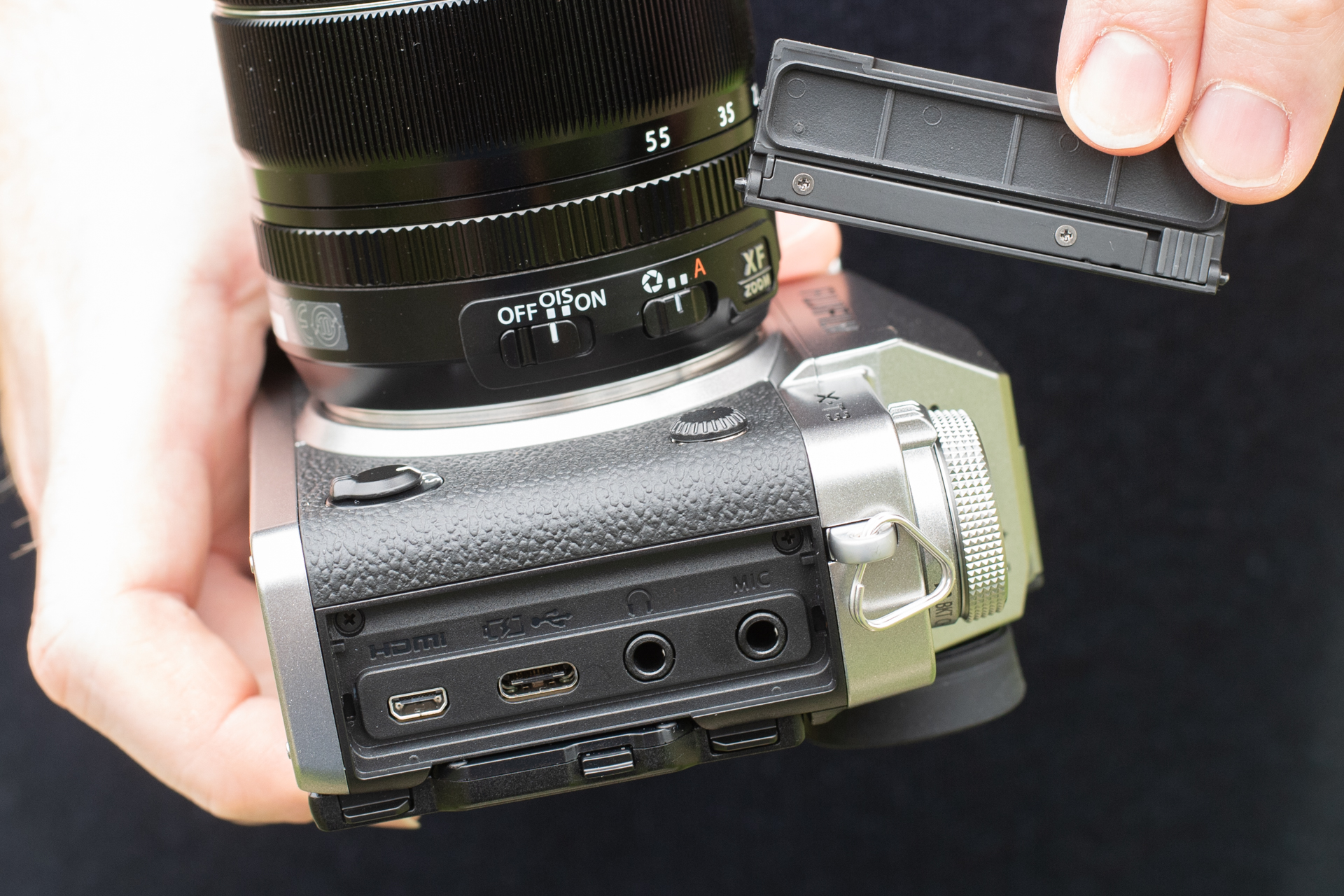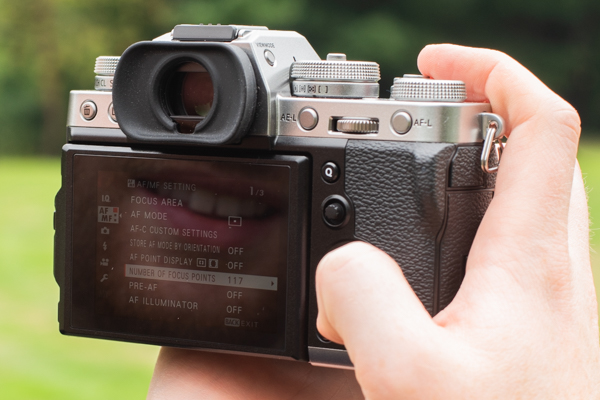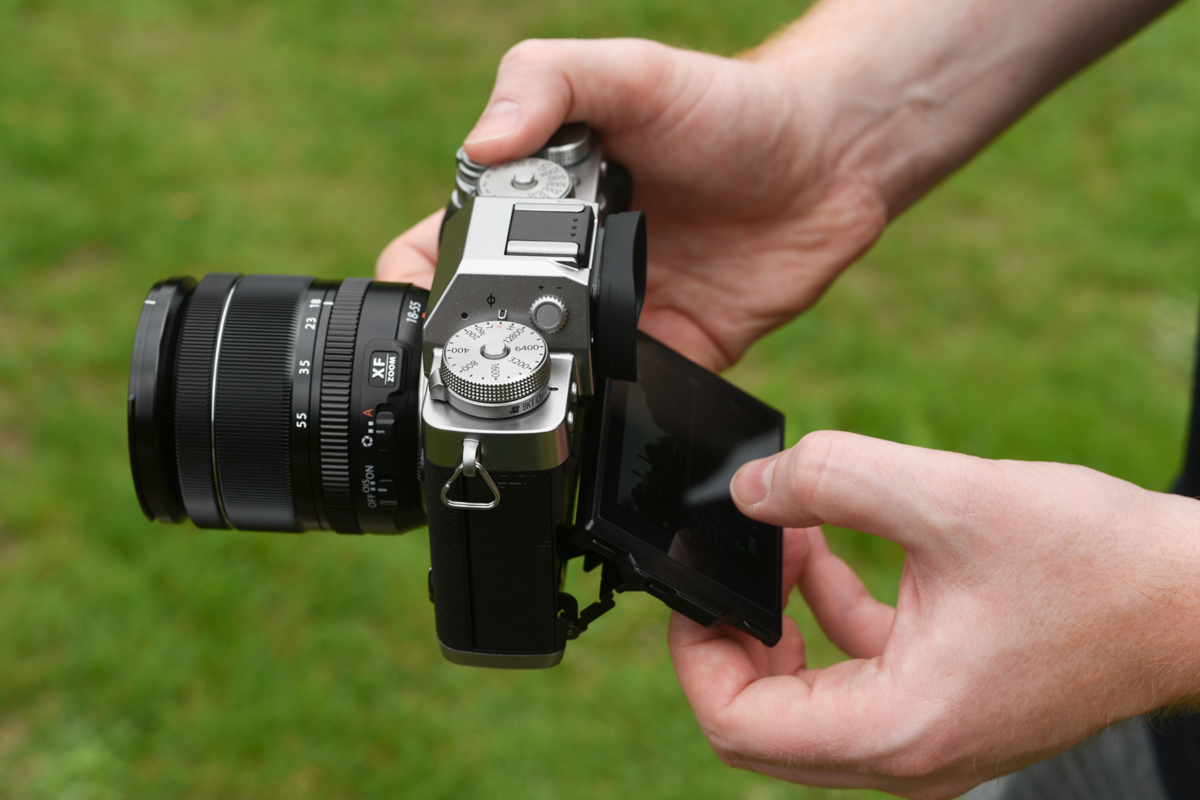Fujifilm has now crafted a number of camera lines for the more discerning photographer, from compacts you can slip into your pocket to interchangeable-lens cameras bolstered by an ever-growing range optics and accessories.
In contrast to its more rangefinder-esque X-Pro line, the X-T series has traditionally been focused around DSLR-type design and operation, with a more defined grip and dual command dials, together with a centrally positioned viewfinder. The new Fujifilm X-T3 appears every bit as handsome as its X-T1 and X-T2 forebears, but it arrives with a considerably stronger feature set than before.
With an APS-C sensor and a four-figure asking price, it occupies the more senior end of the enthusiast camera market, with a particularly broad set of competitors to fight against. With a good helping of fresh technology on board, however, there's a great deal to get excited about, whether you're an existing X Series user or not.
Features
- 26.1MP back-illuminated sensor
- 4K video to 60p (4:2:0 10-bit internal)
- 11fps burst shooting (up to 20fps with electronic shutter)
The X-T3's sensor is new, a fourth-generation X-Trans CMOS sensor with a back-illuminated design. Fujifilm claims that this should better support a lens with a maximum aperture of f/1, the first example of which will be the XF 33mm f/1.0 R WR that’s due for release in 2020.
The new sensor also lowers the native base sensitivity from ISO200 on previous models to ISO160. This move will also no doubt be welcomed by wide-aperture lens users, as it makes it easier to use such lenses in brighter conditions when you don’t have an ND filter to hand.
Fujifilm has also blessed the X-T3 with a fresh processing engine, the X-Processor 4, and this appears to be behind many of the camera’s changes, including a reduction in start up time – now down to 0.3sec – and a shutter lag interval of 0.045sec.
In addition to 11fps burst shooting with the mechanical shutter – which, on the X-T2 is only possible through the Vertical Power Booster – and 20fps with the electronic shutter, the camera can be placed into a Sports Finder mode, which applies a 1.25x crop to the frame and outputs images at 16.6MP, while boosting burst speed to 30fps. Impressively, Fujifilm claims the camera will continue to auto-expose and autofocus during the burst, with no blackout between frames.
While the X-T3 doesn’t debut any new Film Simulation modes as such, there have been a few changes to the general offering. The Color Chrome option, which first surfaced in the GFX 50S has made its way here, and this is designed for highly saturated subjects whose details may otherwise fail to record well (such as vibrant flowers).

There are also new Cool Black and Warm Black toning options on hand when recording images on either the Monochrome or ACROS settings, which apply blue and sepia tints respectively to images. These mimic the similar kinds of effects that would traditionally be achieved through different developers in the film era, and they can be applied in nine separate increments in either direction, for either slight or pronounced effects.
The above options join the existing 11 Film Simulation settings that have 16 possible variations when the yellow, red and green colour filters for the Monochrome and ACROS options are taken into account.
The X-T2’s video specs were already more than credible, but things have moved on further still here with the X-T3
Wi-Fi and Bluetooth are on board, as it a USB Type C port that can be used to charge the battery while it's inside the camera. The 390-shot frame rate per charge (when using the EVF) represents a 60 frame increase from the X-T2, which is still behind DSLRs of the same level but ahead of many other mirrorless models. Dual card slots, both of which support SDHC and SDXC cards up to the UHS-II standard, are located at the side of the body through their own door.
The X-T2's video specs were already more than credible, but things have moved on further still here with the X-T3. The camera is the only current APS-C-based mirrorless camera that can capture 4K video at 60fps internally with 4:2:0 10bit output, with an F-Log shooting profile able to be selected and both headphone and microphone ports on the side of the body. A firmware update that will make the camera compatible with Hybrid Log Gamma is also promised later this year.
Build and handling
- Weather-resistant design
- Die-cast magnesium-alloy body
- Shutter speed, ISO and exposure compensation dials
For the design of the X-T3’s body, Fujifilm hasn’t changed a great deal from the X-T2, which itself wasn’t too far removed from the X-T1 – but a handful of changes have been made.
There's a bit more room on the back for the thumb to sit and some of the buttons on the back plate are both slightly larger and easier to press into the body than before. The dials have been very gently redesigned, and the diopter control also now needs to be pulled out of he body before it’s adjusted, which helpfully prevents it from being inadvertently knocked.
The exposure compensation dial has also moved a little further into the body to minimise the risk of the same thing happening, although it cannot be locked in place like the shutter speed and ISO dials, and so it still appears somewhat susceptible to the issue. There seems to be no good reason why this can’t have the same kind of locking button as the other dials, even if its smaller size would make adjustments a little more fiddly here.

The door to the ports at the side of the camera can also now be removed (above) to allow for multiple cables to be used without it getting in the way. You just slide down the catch and the door comes away quite easily.
Build quality is just as solid as we’ve come to expect for an X-T model, as is attention to detail around the body and its various controls; Fujifilm hasn’t cut corners here. The camera weighs 539g without a lens and 869g with the XF18-55mm f/2.8-4 R LM OIS kit lens attached, and it feels substantial.
Those using longer lenses may wish for a body with a deeper and/or more sculpted grip, as the one here only offers so much room for purchase. Naturally this would compromise portability, but the camera is already somewhat weighty before you put a lens on, so a marginally deeper grip would probably support all but the smallest pancake lenses a little better. Still, those with average-sized hands will probably consider the shape of the grip and the protrusion at the side of the rear plate, together with the good use of rubber on each, to provide a more than adequate hold.
Overall, the setup provides a positive shooting experience. The presence of an AF lever makes adjusting the focusing points easy, whether you're moving left to right, up or down, or diagonally, while the ease with which the command dials rotate and the way they positively click into the body makes changing settings pain-free.
The ability to customise so many of the camera's controls also makes it easy to quickly call upon the Sports Finder option or a different Film Simulation mode among other things, so if you imagine you'll be alternating between these with any regularity you'll probably be very happy with how easy Fujifilm has made it for you. The front-plate's Fn button in particular is located right where the middle finger can quickly access it without you needing to reposition your hand.
If you're a left-eye shooter, one thing you may find is that your nose gets in the way of the AF lever and some of the directional buttons on the menu pad when you're looking through the viewfinder.
Autofocus
- Hybrid phase- and contrast-detect AF system
- 2.16million phase-detect AF pixels
- 425 AF points
While the X-T3 maintains the same kind of phase- and contrast-detect AF system as the X-T2, the new sensor and processor have changed what's possible.
The sensor on the X-T3 now offers 2.16-million phase-detect AF pixels that stretch across approximately 99% of both vertical and horizontal axes. This is a four-fold increase over the X-T2’s 500k pixels, and the wider distribution means that the system should be able to maintain a similar performance across the whole area. This is particularly key when shooting video or when using continuous focus, where phase-detect AF pixels are better suited to keeping track of moving subjects.

425 AF points can be manually addressed by the user, but you can knock this back to 117 points if you don’t want to have to move through so many to get around. It’s also possible to adjust the size of the focusing area so that the camera can more accurately focus on the subject. So, for example, you may want to make this as small as possible when focusing on the stamens of a flower, as the camera may not identify them as easily otherwise.
When used for everyday shooing, the camera is capable focusing quickly and precisely on a range of subjects, and focusing is very quiet with the aforementioned 18-55mm kit lens. The slight hesitations against low-contrast subjects are expected, and the camera does occasionally struggle here, but it generally does well when lighting conditions aren't great (more so in the Wide/Tracking and Zone options than when you've defined the AF point yourself)
Fujifilm has developed a fairly comprehensive selection of options over continuous focus, and you can choose from a Canon-like collection of presets to suit different kinds of moving subjects
Fujifilm has developed a fairly comprehensive selection of options over continuous focus, and you can choose from a Canon-like collection of presets to suit different kinds of moving subjects – and if none of these match you can create you own. We were very pleased with the camera’s ability to keep track of moving subjects when we first handled it at the official launch, and using it again confirms how well this works.
Most of the time when focusing on a moving subject, the camera acquires focus in very good time, although this will depend partly on the lens used. There were a handful of occasions during this review where the focusing system struggled to get a lock initially, and other times when the camera would lose focus for a couple of frames before regaining it again, but 90% of the time it appeared to adhere to the main subject without issue.
The system appeared to stay very well with subjects as they moved towards or away from the camera, and the spread of phase-detect AF points meant that the camera was able to track these right to the peripheries. Considering how ill-suited mirrorless cameras used to be for these tasks next to DSLRs, the X-T3's performance is commendable.

The Sports Finder Mode outputs images at 4992×3328 pixels, which equates to 16.6MP
Using the Sports Finder mode here at 30fps, the camera delivers on its promise of blackout-free shooting, and you retain visibility of the AF system working as it powers through these, although this speed does mean you can't quite appreciate every frame being captured (you do get a flashing icon on the top-left-hand side of the screen as this happens).
A camera's ability to detect eyes when shooting portraits has become a sought-after feature in recent years, and Fujifilm claims to have improved face/eye detection for the new model. And its ability to detect eyes also proved to be very good; as we might expect, it did occasionally fail to achieve the initial lock-on if the subject only occupied so much of the frame, or in high-contrast conditions, but it proved itself to be a very good performer when the subject was the main element in the scene, and as it moves around.

Face and eye detection is very effective
The touchscreen can also be used to focus on subjects, and also to capture the image as soon as the camera has acquired this, if you want it to do so. Even with the XF18-55mm f/2.8-4 R LM OIS kit lens, focusing happens promptly and quietly, and this is particularly useful when using a tripod. The responsiveness of the screen makes it easy to accidentally knock and focus or capture an image when you're not intending to do so, however, so you may want to deactivate this for general use.
Performance
- 3.2in LCD touchscreen, 1.04million dots
- Detailed EVF, but susceptible to coloured fringing
- Great response during image processing
The earliest mirrorless cameras were often a little sluggish upon start up, something you particularly noticed if you were coming from a DSLR. Slowly the gap narrowed and models like the X-T3 show you just how far it’s come. While it’s not quite instant, there’s just the briefest pause before the camera is ready, with the autofocus system, viewfinder/LCD feed and all the shooting information falling into place simultaneously.
Response continues to be strong as you operate the camera. It responds immediately as you adjust things like exposure compensation and shutter speed, and there’s just the briefest lagging as you navigate the menus. Holding down one of the directional menu pad buttons zips through captured images at a very fast pace, which makes scanning through a whole day’s shooting effortless.
When set to capture images continuously, the camera meets its 35 frame raw and JPEG buffer depth, and it manages to flush this to the memory cards in a matter of just a few seconds. Perhaps most impressively, it doesn't freeze up as it does this, which means that you can still enter the menus and adjust settings at any point.
The viewfinder has been revamped from the X-T2’s, the main change being its resolution. In place of the 2.36-million dot panel from before, we now have a 3.69-million-dot alternative, which refreshes itself at a rate of up to 100fps when used in the BOOST mode. We’re starting to see viewfinders with this kind of resolution on high-end models, but to have it on a non-flagship camera at this price point is great to see. Magnification is a respectable 0.75x and Fujifilm states a lag time of 0.005sec.

The X-T3's viewfinder itself is very nice and crisp, and you really appreciate this when you temporarily zoom into the display when composing images. One issue we discovered when we first got our hands on the camera upon its launch, however, doesn’t appear to have been rectified here. Coloured fringes frequently appear on the edges of certain subjects, and these are quite prominent at times. This happens when shooting both colour and black and white images, although they do not appear in the final image itself.
The LCD screen beneath this has the same 3.2-inch dimensions and 1.04-million dot resolution as the X-T2, together with the same three-way tilt mechanism, which allows it to be used more easily in a portrait orientation when away from your face. The screen is nice and detailed and there’s little to fault, though, as with pretty much all similar screens, in bright light it benefits from having its brightness adjusted a touch.

The only difference of any significance between the X-T2's screen is that it's now sensitive to touch on the X-T3. You can use this to set the focusing point, choose and adjust Q menu options (though nothing in the main menus), swipe through captured images and zoom into them among other things. Response in general is very good, particularly when setting the AF point and when zooming around images to check focus and detail.
The only real issue is a relatively common one, namely that moving your hand around the display can fool the viewfinder’s sensor into thinking your face is approaching, and this switches the feed to the viewfinder. The viewfinder’s deep eyecup is very much appreciated when shooting in strong light although it would be good to have the LCD extend a little further out from the body when tilted as it obscures the top of the display when this is pulled out at a 90-degree angle to the body.
Image quality
- 14-bit Raw shooting
- 11 Film Simulation modes (16 separate options)
- Color Chrome Effect
We’ve become used to Fujifilm using a particular sensor in a number of its models, but this is the first time we’ve seen this 26.1MP X-Trans CMOS 4 version. The modest increase in resolution over the previous 24MP version isn’t anything too exciting, but the fact that it has a back-illuminated design bodes particularly well for those who tend to capture images at the higher end of the ISO range.

While in-camera noise reduction can take away a little detail, noise in Raw files captured as high as ISO12,800 is pleasingly low. The above is an in-camera JPEG with default noise reduction.
So it’s great to see that noise appears to be very well controlled by the X-T3 throughout the range, and stays good at higher settings. Only a minimal amount of texture can be seen in low-ISO images, in exactly the sorts of places we expect (large, detail-less areas such as skies). Raw files captured at the highest native setting of ISO12,800 retain good detail and show noise to not be aggressive at all, which makes the default ‘0’ noise reduction option for JPEGs appear a little heavy-handed (you can scale this right back to -4).
Exposures seem well judged by the X-T3's metering system, with the default pattern behaving with a pleasing predictability. The centre-weighted average option, meanwhile, appears to do perfectly well to maintain good exposure on a brighter subjects while keeping the background appropriately exposed.
The only times where exposure compensation was necessary during this review was when capturing larger areas of bright skies, which would force most cameras to underexpose, and also when a particularly bright subject only occupied some of the frame, where highlight detail was at risk of being lost. With the exposure compensation dial falling close to the hand on the X-T3, it's easy to make slight adjustments when you see fit.

The XF18-55mm f2.8-4 R LM OIS kit lens is a reasonable performer, but a superior optic, such as the XF50-140mm R LM OIS WR used here, shows you what the new sensor is really capable of
Fujifilm's Film Simulation options are now well established, and arguably something of a draw for anyone after print-ready images with great colors straight from the camera, and there's little to gripe about here.
The default Provia/Standard mode delivers pleasing results and the Velvia/Vivid option injects a welcome vibrancy, one that's only over the top when shooting scenes with more saturated colors. The auto white balance system is accurate in natural conditions too, and its performance under mixed natural and artificial lighting – a headache for many cameras – also proved to be surprisingly good, retaining the ambience of the scenes very well.
It’s possible to process raw images in camera on the X-T3 once you’ve captured them, and there’s a healthy range of options to choose from, including the new toning options and Color Chrome Effect
It’s possible to process raw images in camera on the X-T3 once you’ve captured them, and there’s a healthy range of options to choose from, including the new toning options and Color Chrome Effect. Sadly, changes are not applied in real time, which means you end up having the guess how much adjustment is necessary before you can see what change this makes. Fujifilm should really pay attention to companies like Panasonic and Nikon have implemented their equivalent systems, as these are far more usable. In fairness to Fujifilm, Sony still hasn’t implemented this function into its cameras, so at least we have one here.
Video footage from the X-T3 is very good, whether you’re capturing conventional 4K footage or using on of the camera’s slow-motion options. Footage is pleasingly free from artefacts and detail remains nice and crisp overall. Sound quality isn’t too bad either; the camera can pick up a little wind noise, but anyone using the X-T3 for more considered recording will no doubt be using a superior microphone through the port at the camera’s side.
Verdict
The X-T3 may appear as a ringer for the X-T2, and anyone used to the series will feel very familiar with the X-T3 brings. That said, a multitude of changes make this a far more powerful camera, and it’s great to see that attention has been placed on core areas and smaller details alike.
The new sensor captures very good detail when used with a good lens, and keeps noise levels low, while the wide-spread of phase-detect AF points across its surface allows subjects travelling anywhere across the frame to be kept in focus. Video quality remains strong, while the upgraded processing system also ensures that the camera remains responsive at all times.
Aside from the issue we encountered with EVF, it’s only really small design and operational quirks that frustrate. It would be good to see the next X-T model have a redesigned grip that would support the camera better when using longer lenses, for example, and a lockable exposure compensation dial.
Overall, while it may currently be one of the priciest APS-C cameras you can buy, Fujifilm has done well to deliver a very well rounded feature set inside a robust body that’s a pleasure to use.